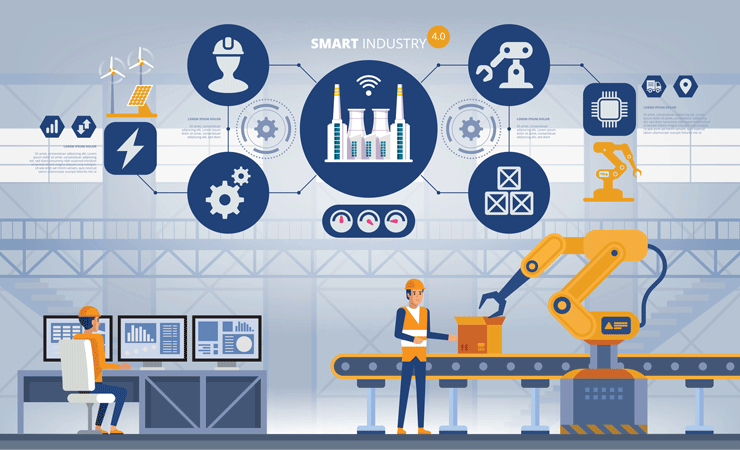Smart Factories
What are they and are they relevant for SMEs?

Smart factories are coming into focus as businesses put more resources behind productivity and efficiency.
A recent survey by the Manufacturer’s Alliance for Productivity and Innovation found that 86% of U.S. manufacturers believe smart factory initiatives will be a main driver of competitiveness over the next five years.
Another study showed that even during the pandemic, 62% of leaders are continuing smart factory investments, allocating 20% more to those initiatives than last year.
What is a Smart Factory?
According to the CMTC, a think tank aimed at improving manufacturing efficiency, a Smart Factory is a “highly digitized and connected production facility that relies on smart manufacturing which is a technology-driven approach that utilizes internet-connected machinery to monitor the production process.”
So, essentially it is about more automation, connectivity, and the internet.
But we are a long way from that Orwellian dream.
An objective for smart factories is to minimize human intervention in the production process. The perfect smart factory of the future will be a black box operation needing no lights or windows as it is fully automated.
Whilst this is meat and drink for the big boys who can afford to have teams of computer scientists working on their future factory, what does it mean for SMEs?
It means you need to take note of it and think long and hard about your production process and automation. The thing about technology is that it is daily becoming more affordable.
Many years ago, Gordon Moore forecasted that computer processor power would double every 18 months. He was proven right, and so Moore’s Law was born.
Around the same time, at the launch of Apple Computers, founder, Steve Jobs predicted that you would soon be able to store 1Gb of data on a microchip. At the time, his new Apple computer boasted a market-leading 48Kb (max), and he went on to say that if you wanted to store 1Gb data on a current technology microchip, the chip would need to be size of tennis court!
Today you can Google the availability of 5GB microchips. Yesterday’s dream is today’s reality.
For a long time now, systems integrators have been linking your back-office ERP system to your production facility with simple counters and weigh-scales, collecting data automatically rather than keying it in (and making errors).
The whole world of artificial intelligence (AI) is impacting our daily lives and becoming (often an unseen) reality. Have you noticed how Google Maps predicts your journey and warns you of possible hold ups on a familiar route? It knows that at 7.30 am you start the school run.
In the world of fresh produce, grading machines use imaging technology and rudimentary AI to drive automated production. The cameras and scanners can check for color, size, external damage and even damage inside of the produce, and route the produce dependent on its characteristics. This technology used to cost millions, but today is common-place and widely used even within the smaller pack-houses.
Your peers are doing this now. SOS customer FatSnax makes keto based healthy snacks. It was founded just 3 years ago. In the last year, the business grew 5-fold. So how does production keep up with that? Operations Director, Ted Watson has the answer. “Automation is key, our production facilities are on the smaller side, but with automated form and seal machines and various other packing equipment, they are able to keep in step with our growth.”
What can a Smart Factory deliver?
Smart factory investments can have immense benefits operationally, financially and throughout the workplace. Productivity and efficiency, for example, have risen to the forefront and increasingly determine an organization’s overall success in the marketplace.
The CMMT say that those who embrace the smart factory see an average of 20% improved efficiency. They optimize functions while reducing changeover and downtime, producing products quicker and with less effort. And they don’t sacrifice product quality along the way, either. Typically, these organizations are seeing product quality improvements of 30% — a key component of customer satisfaction as the marketplace evolves.
So, with the march of technology, smart factory investments help drive costs down at a time when business leaders and investors are closely monitoring budget spend.
Technology can be very democratizing. What was previously available to only the large corporates is now becoming available to SMEs. The internet is the underlying technology making much of this possible.
The internet of things recognizes that most equipment these days is intelligent, meaning that can be accessed by the internet. Many have internet enabled fridges in our homes and at this time of year, many of us are wrestling with internet enabled Christmas tree lights.
So, connecting with production machinery is an everyday occurrence. It just needs to be joined up with your back offices systems, for launching orders, scheduling and planning and production feedback.
The presumption is that you have an ERP to drive the business and the factory and collect the data for analysis. If you don’t yet have one, and many SME manufacturers still don’t, favoring the apparent ease, cost, and flexibility of spreadsheets, you will need one. You cannot create a joined-up company driving a smart factory, if you have spreadsheets creating unintegrated and unsynchronized silos of departmental data.
How to select an ERP system that is relevant to your business is, as with most things, easy if you know how. If you don’t know how, it is very easy to buy a costly mistake.
Selecting a system that is relevant to your business and easy-to-use is the subject of another paper!